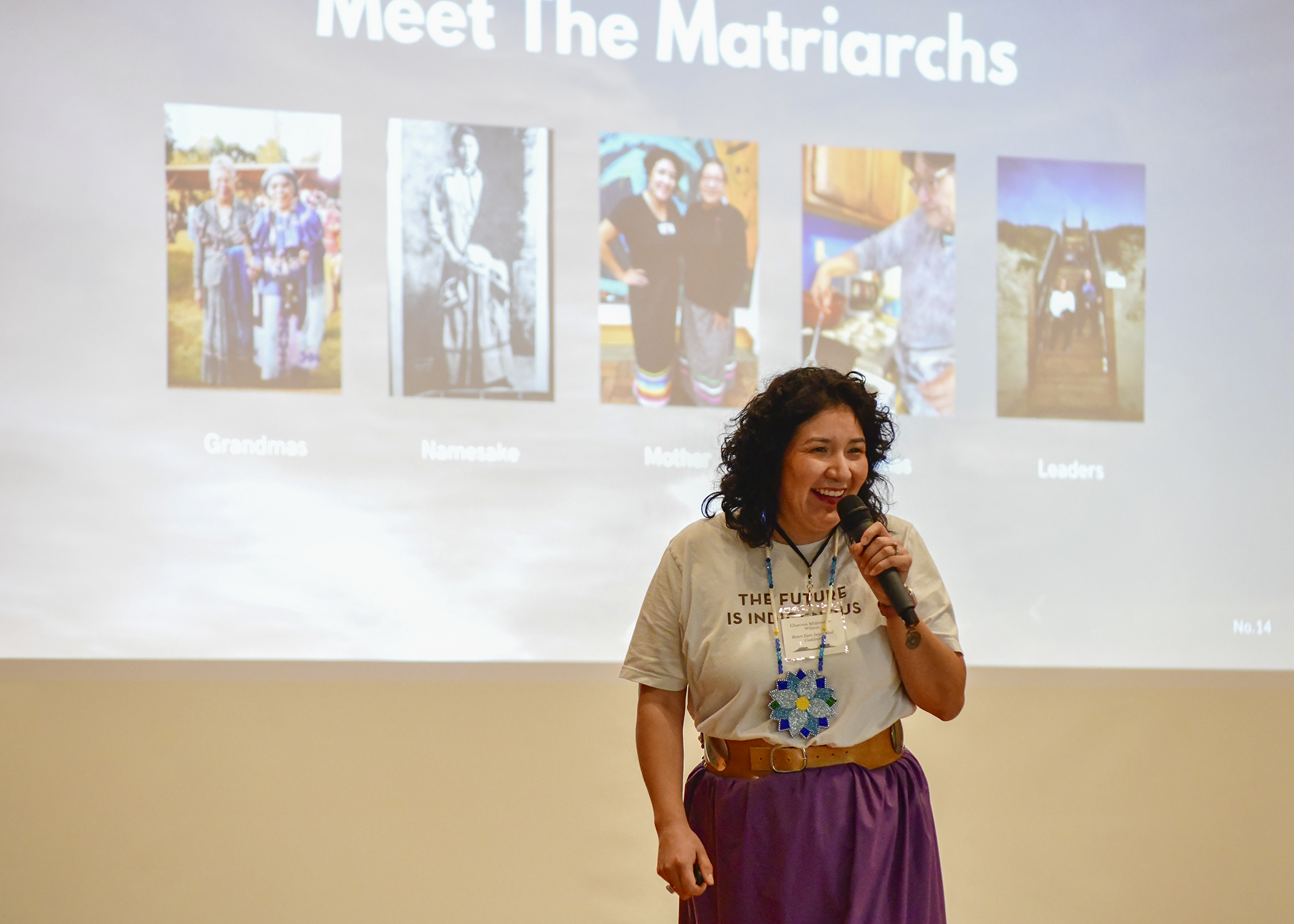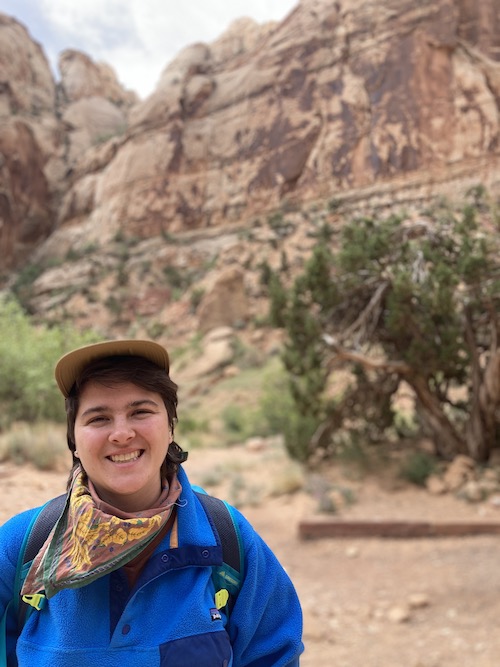Over the weekend of March 8, I had the opportunity to attend Celebrate Bears Ears in Bluff in the first few days of coming on as the new Communications Manager.
In many ways, it was a perfect - if unexpected - way to start this new role. I got to meet the wonderful staff, board, and community members I am now working with, and get a feel for how the greater Bears Ears community works together on its shared mission to protect this important landscape.
The day was full of inspiring panels, presentations, and speakers. NGO partners tabled along the walls of the Bluff Community Center, and outside, local Indigenous artisans displayed their work.
 Executive Director Joe Neuhof and Board President David Nimkin celebrate outgoing board members Vaughn Hadenfeldt, Marcia Simonis, and Steve Simpson. Photo by Tim Peterson.
Executive Director Joe Neuhof and Board President David Nimkin celebrate outgoing board members Vaughn Hadenfeldt, Marcia Simonis, and Steve Simpson. Photo by Tim Peterson.
As I listened to each speaker, I filled my notebook pages with thoughts and questions, knowing that while these projects were new to me, they would soon become familiar, and that I would continue to reflect on and learn from the values behind them.
One panel discussed the importance of intergenerational connection, how the Ancestral Lands Conservation Corps helps to facilitate “cultural continuity,” and how healing the land can help heal ourselves. The Visit With Respect team also debuted the new short documentary about this influential program to protect the Bears Ears region’s cultural sites and ecology.
When representatives from the US Forest Service and BLM discussed public-private partnerships, there was palpable anticipation to hear more about the recently released Draft Monument Management Plan. This draft plan proposes a number of alternatives for co-management between federal and state agencies and the Bears Ears Inter-Tribal Coalition – and the agencies will listen to feedback from organizations like BEP and the general public. While no one in the audience had had a chance yet to read through the entire 12,000-page document, the overall mood was celebratory, commemorating the achievement of the plan’s release, as well as the unprecedented co-management that it represents.
I was particularly struck by the keynote presentation, from Charisse Miijeseppe-Wilson, co-director of Bears Ears Inter-tribal Coalition, titled “The Lands Lead Us: Indigenous Learnings in Conservation, Leadership, and Movements.” Miijeseppe-Wilson shared how she approaches her leadership based on Indigenous teachings.
 Charisse Miijeseppe-Wilson, co-director of Bears Ears Inter-tribal Coalition, was the keynote speaker for Celebrate Bears Ears. Her presentation was titled “The Lands Lead Us: Indigenous Learnings in Conservation, Leadership, and Movements.” Photo by Tim Peterson.
Charisse Miijeseppe-Wilson, co-director of Bears Ears Inter-tribal Coalition, was the keynote speaker for Celebrate Bears Ears. Her presentation was titled “The Lands Lead Us: Indigenous Learnings in Conservation, Leadership, and Movements.” Photo by Tim Peterson.
Unfortunately, I had to miss the afternoon sessions to drive back to my home in Salt Lake City. The day continued on with presentations about Indigenous outreach and ancestral connections to The Lands Between, science and conversation at Dugout Ranch, the program to protect dark skies, and closing remarks by BEP Board President David Nimkin.
But on that drive, I reflected on all I had heard at Celebrate, full of gratitude for the community helping me feel welcomed, and inspired by the powerful collective purpose. While I am still new to this region, many of the themes I heard were familiar, such as the importance of Indigenous leadership in conservation, listening deeply, and practicing humility.
Before coming to BEP, I moved to Salt Lake City to begin the University of Utah’s Environmental Humanities graduate program. Going to grad school had been an intentional break from community organizing, which I had done for several years in the Great Lakes region.
While I have lots to learn about the history of the Bears Ears region, I recognized the shared reverence for the land, and the shared motivation to protect the land as a community. Growing up in Michigan, the Great Lakes influenced my understanding of what it means to protect a place, and belong – as a non-Indigenous guest on the land. I was involved in grassroots movements to stop the Line 3 oil pipeline, and pressure Chase Bank, the largest funder of climate change, to defund fossil fuels. While the particular histories of these landscapes may differ, all of these struggles are connected – these landscapes face similar kinds of threats, and are home to communities of people coming together to protect them.
 Amelia Diehl was hired on as the new BEP Communications Manager in March.What I’ve learned from my years organizing in climate justice movements is that social change is always an ecosystem. Just as an ecosystem has many interdependent components working together for mutual benefit, each organization cannot do this work alone, nor can they take on all of the many facets of the necessary work. In turn, each campaign also calls for many different kinds of strategies to be successful. Events like Celebrate, where an advocacy community can come together and hear about each other’s work, are so important for reaffirming that everyone has a role to play, because this mission is too big for any one person alone.
Amelia Diehl was hired on as the new BEP Communications Manager in March.What I’ve learned from my years organizing in climate justice movements is that social change is always an ecosystem. Just as an ecosystem has many interdependent components working together for mutual benefit, each organization cannot do this work alone, nor can they take on all of the many facets of the necessary work. In turn, each campaign also calls for many different kinds of strategies to be successful. Events like Celebrate, where an advocacy community can come together and hear about each other’s work, are so important for reaffirming that everyone has a role to play, because this mission is too big for any one person alone.
To me, communications work is about making that ecosystem of change visible and felt to those who are involved, as well as those we are trying to motivate to act. An important part of that ecosystem is storytelling, or the narratives made implicit or explicit about what is important, why we act, and how we act. Instead of only seeing what’s directly in front of us, stories help us affirm our individual and collective place in a broader context.
All social change relies on storytelling, as we are resisting the stories being told to us that pave the way for extraction and exploitation of the land. What I heard at Celebrate were stories of collaboration, respect for land and history, and a dedicated hope.
All of this to say, I’m honored to join the Bears Ears Partnership team as Communications Manager, and excited to collaborate, learn, and deepen relationships with the land as well as everyone in this ecosystem of change. Celebrate is as much a necessary celebration as it is a rallying cry for the work ahead.

